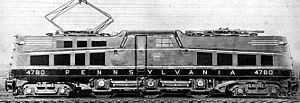PRR P5
| PRR P5 | |||||||||||||||||||||||||||||||||||||
|---|---|---|---|---|---|---|---|---|---|---|---|---|---|---|---|---|---|---|---|---|---|---|---|---|---|---|---|---|---|---|---|---|---|---|---|---|---|

P5a (modified) #4780.
|
|||||||||||||||||||||||||||||||||||||
|
|||||||||||||||||||||||||||||||||||||
|
|||||||||||||||||||||||||||||||||||||
|
|||||||||||||||||||||||||||||||||||||
| Type and origin | |
|---|---|
| Power type | Electric |
| Builder | PRR Altoona Works (13) Baldwin-Westinghouse (54) General Electric (25) |
| Build date | 1931–1935 |
| Total produced | 92 |
| Specifications | |
|---|---|
| Configuration: |
|
| • UIC | 2'Co2' |
| Gauge | 4 ft 8 1⁄2 in (1,435 mm) standard gauge |
| Leading dia. | 36 in (914 mm) |
| Driver dia. | 72 in (1,829 mm) |
| Trailing dia. | 36 in (914 mm) |
| Wheelbase | 49 ft 10 in (15.19 m) (total); 20 ft (6.10 m) (rigid) |
| Length | 62 ft (19 m) |
| Width | 10 ft 6 in (3.20 m) (P5, P5a, P5b); 10 ft 8.25 in (3.26 m) (P5a (modified)) |
| Height | 15 ft (4.57 m) over locked-down pantographs |
| Axle load | 74,000 lb (34,000 kg; 34 t) (P5, P5a); 77,800 lb (35,300 kg; 35.3 t) (P5b); 77,000 lb (35,000 kg; 35 t) (P5a (modified)) |
| Adhesive weight | 220,000 lb (100,000 kg; 100 t) (P5, P5a); 444,700 lb (201,700 kg; 201.7 t) (P5b, all wheels driven); 229,000 lb (104,000 kg; 104 t) (P5a (modified)) |
| Loco weight | 392,000 lb (178,000 kg; 178 t) (P5, P5a); 444,700 lb (201,700 kg; 201.7 t) (P5b); 394,000 lb (179,000 kg; 179 t) (P5a (modified)) |
| Electric system/s | 11 kV AC @ 25 Hz Catenary |
| Current pickup(s) | Pantograph |
| Traction motors | 6 × 625 hp (466 kW) AC motors; plus 4 × 375 hp (280 kW) motors on the trucks on P5b |
| Transmission | AC current fed via transformer tap changers to paired motors geared (25:97) to quill drives on each driving axle; plus single motors geared to driving axles on end trucks on P5b (gear ratio: 17:50) |
| Career | |
|---|---|
| Operators | Pennsylvania Railroad |
| Numbers | 4700–4791 |
| Preserved | 4700 |
| Disposition | Museum of Transportation in St Louis, Missouri |
The Pennsylvania Railroad's class P5 comprised 92 mixed-traffic electric locomotives constructed 1931–1935 by the PRR, Westinghouse and General Electric. Although the original intention was that they work many passenger trains, the success of the GG1 locomotives meant that the P5 class were mostly used on freight. A single survivor, prototype #4700, is at the Museum of Transportation in St Louis, Missouri.
They had an AAR wheel arrangement of 2-C-2, or 2'Co2' in the UIC classification system — three pairs of driven wheels rigidly mounted to the locomotive, with a two-axle unpowered truck at each end.
The first P5s were built with box cabs. A grade crossing accident in which the crew were killed led to the substitution of a streamlined steeple type cab in later production, a design which was also applied to the GG1.
When the GG1s were put in passenger service, the P5s were regeared and used in freight service for many years. The last of the class was withdrawn from service in April 1965.
Two prototype locomotives were outshopped from the PRR's Altoona Works in 1931. They were essentially the PRR's 2-B-2 O1 design lengthened by adding another pair of driving wheels; while the O1 was an "electric Atlantic" equivalent to the E6s steam locomotive, the P5 was an "electric Pacific" designed to match or better the performance of the PRR's ubiquitous K4s Pacifics.
These prototypes had electrical equipment from both Westinghouse and General Electric; the design was by both companies and the PRR's electrical department, and the equipment from either manufacturer was identical.
Orders were placed for 90 production locomotives classified P5a due to minor changes from the prototypes (notably, larger traction motor blowers). Production was split between General Electric and Westinghouse; the GE examples were assembled at GE's Erie, Pennsylvania facility, still a locomotive assembly plant today, while final assembly for the Westinghouse order was subcontracted to the Baldwin Locomotive Works.
...
Wikipedia
